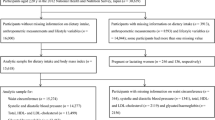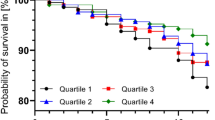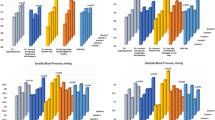Abstract
Aims/hypothesis
Dietary patterns have been associated with the incidence of type 2 diabetes, but little is known about the impact of ethnicity on this relationship. This study evaluated the association between four a priori dietary quality indexes and risk of type 2 diabetes among white individuals, Japanese-Americans and Native Hawaiians in the Hawaii component of the Multiethnic Cohort.
Methods
After excluding participants with prevalent diabetes and missing values, the analysis included 89,185 participants (11,217 cases of type 2 diabetes). Dietary intake was assessed at baseline with a quantitative food frequency questionnaire designed for use in the relevant ethnic populations. Sex- and ethnicity-specific HRs were calculated for the Healthy Eating Index-2010 (HEI-2010), the Alternative HEI-2010 (AHEI-2010), the Alternate Mediterranean Diet Score (aMED) and the Dietary Approaches to Stop Hypertension (DASH).
Results
We observed significant inverse associations between higher DASH index scores and risk of type 2 diabetes in white men and women, as well as in Japanese-American women and Native Hawaiian men, with respective risk reductions of 37%, 31%, 19% and 21% (in the highest compared with the lowest index category). A higher adherence to the AHEI-2010 and aMED diet was related to a 13–28% lower risk of type 2 diabetes in white participants but not in other ethnic groups. No significant associations with risk of type 2 diabetes were observed for the HEI-2010 index.
Conclusions/interpretation
The small ethnic differences in risk of type 2 diabetes associated with scores of a priori-defined dietary patterns may be due to a different consumption pattern of food components and the fact that the original indexes were not based on diets typical for Asians and Pacific Islanders.
Similar content being viewed by others
Abbreviations
- AHEI:
-
Alternative Healthy Eating Index
- aMED:
-
Alternate Mediterranean Diet Score
- CARDIA:
-
Coronary Artery Risk Development in Young Adults
- DASH:
-
Dietary Approaches to Stop Hypertension
- HEI:
-
Healthy Eating Index
- HPFS:
-
Health Professionals Follow-Up Study
- MEC:
-
Multiethnic Cohort
- MPED:
-
MyPyramid Equivalents Database
- PEE:
-
Proportion of exposure effect
- QFFQ:
-
Quantitative food frequency questionnaire
- SSB:
-
Sugar-sweetened beverage
References
Maskarinec G, Erber E, Grandinetti A et al (2009) Diabetes incidence based on linkages with health plans: the multiethnic cohort. Diabetes 58:1732–1738
Grandinetti A, Kaholokula JK, Theriault AG, Mor JM, Chang HK, Waslien C (2007) Prevalence of diabetes and glucose intolerance in an ethnically diverse rural community of Hawaii. Ethn Dis 17:250–255
Hu FB (2002) Dietary pattern analysis: a new direction in nutritional epidemiology. Curr Opin Lipidol 13:3–9
Gao SK, Fitzpatrick AL, Psaty B et al (2009) Suboptimal nutritional intake for hypertension control in 4 ethnic groups. Arch Intern Med 169:702–707
Liese AD, Nichols M, Sun X, D'Agostino RB Jr, Haffner SM (2009) Adherence to the DASH Diet is inversely associated with incidence of type 2 diabetes: the insulin resistance atherosclerosis study. Diabetes Care 32:1434–1436
Zamora D, Gordon-Larsen P, He K, Jacobs DR Jr, Shikany JM, Popkin BM (2011) Are the 2005 dietary guidelines for Americans associated with reduced risk of type 2 diabetes and cardiometabolic risk factors? Twenty-year findings from the CARDIA study. Diabetes Care 34:1183–1185
Erber E, Hopping BN, Grandinetti A, Park SY, Kolonel LN, Maskarinec G (2010) Dietary patterns and risk for diabetes: the multiethnic cohort. Diabetes Care 33:532–538
Kolonel LN, Henderson BE, Hankin JH et al (2000) A multiethnic cohort in Hawaii and Los Angeles: baseline characteristics. Am J Epidemiol 151:346–357
Murphy SP (2002) Unique nutrition support for research at the Cancer Research Center of Hawaii. Hawaii Med J 61:17
Stram DO, Hankin JH, Wilkens LR et al (2000) Calibration of the dietary questionnaire for a multiethnic cohort in Hawaii and Los Angeles. Am J Epidemiol 151:358–370
Sharma S, Murphy SP, Wilkens LR et al (2003) Adherence to the Food Guide Pyramid recommendations among Japanese Americans, Native Hawaiians, and whites: results from the Multiethnic Cohort Study. J Am Diet Assoc 103:1195–1198
Reedy J, Krebs-Smith SM, Miller PE et al (2014) Higher diet quality is associated with decreased risk of all-cause, cardiovascular disease, and cancer mortality among older adults. J Nutr 144:881–889
National Cancer Institute (2013) Dietary Patterns Methods Project. Available from http://appliedresearch.cancer.gov/dietary_patterns/, accessed 08.04.2014
George SM, Ballard-Barbash R, Manson JE et al (2014) Comparing indices of diet quality with chronic disease mortality risk in postmenopausal women in the Women's Health Initiative Observational Study: evidence to inform national dietary guidance. Am J Epidemiol 180:616–625
US Department of Agriculture and US Department of Health and Human Services. Dietary guidelines for Americans, 2010. 7th edn. Washington, DC: U.S. Government Printing Office; 2010. Available from www.cnpp.usda.gov/dietaryguidelines.htm. Accessed 31 May 2014
Guenther PM, Casavale KO, Reedy J et al (2013) Update of the Healthy Eating Index: HEI-2010. J Acad Nutr Diet 113:569–580
Guenther PM, Reedy J, Krebs-Smith SM (2008) Development of the Healthy Eating Index-2005. J Am Diet Assoc 108:1896–1901
Chiuve SE, Fung TT, Rimm EB et al (2012) Alternative dietary indices both strongly predict risk of chronic disease. J Nutr 142:1009–1018
Kennedy ET, Ohls J, Carlson S, Fleming K (1995) The Healthy Eating Index: design and applications. J Am Diet Assoc 95:1103–1108
McCullough ML, Feskanich D, Stampfer MJ et al (2002) Diet quality and major chronic disease risk in men and women: moving toward improved dietary guidance. Am J Clin Nutr 76:1261–1271
Fung TT, McCullough ML, Newby PK et al (2005) Diet-quality scores and plasma concentrations of markers of inflammation and endothelial dysfunction. Am J Clin Nutr 82:163–173
Trichopoulou A, Costacou T, Bamia C, Trichopoulos D (2003) Adherence to a Mediterranean diet and survival in a Greek population. N Engl J Med 348:2599–2608
Fung TT, Chiuve SE, McCullough ML, Rexrode KM, Logroscino G, Hu FB (2008) Adherence to a DASH-style diet and risk of coronary heart disease and stroke in women. Arch Intern Med 168:713–720
National Institutes of Health and Human Services, National Heart Lung and Blood Institute (2006) Your guide to lowering your blood pressure with DASH. Available from www.nhlbi.nih.gov/health/resources/heart/hbp-dash-index.htm. Accessed 8 April 2014
Steinbrecher A, Heak S, Morimoto Y, Grandinetti A, Kolonel LN, Maskarinec G (2012) Various adiposity measures show similar positive associations with type 2 diabetes in Caucasians, Native Hawaiians, and Japanese Americans: the Multiethnic Cohort. Asia Pac J Public Health. doi:10.1177/1010539512440819
Steinbrecher A, Erber E, Grandinetti A, Kolonel LN, Maskarinec G (2011) Meat consumption and risk of type 2 diabetes: the Multiethnic Cohort. Public Health Nutr 14:568–574
Nothlings U, Boeing H, Maskarinec G et al (2011) Food intake of individuals with and without diabetes across different countries and ethnic groups. Eur J Clin Nutr 65:635–641
Doo T, Morimoto Y, Steinbrecher A, Kolonel LN, Maskarinec G (2014) Coffee intake and risk of type 2 diabetes: the Multiethnic Cohort. Public Health Nutr 17:1328–1336
Lin DY, Fleming TR, de Gruttola V (1997) Estimating the proportion of treatment effect explained by a surrogate marker. Stat Med 16:1515–1527
Kodama K, Tojjar D, Yamada S, Toda K, Patel CJ, Butte AJ (2013) Ethnic differences in the relationship between insulin sensitivity and insulin response: a systematic review and meta-analysis. Diabetes Care 36:1789–1796
de Koning L, Chiuve SE, Fung TT, Willett WC, Rimm EB, Hu FB (2011) Diet-quality scores and the risk of type 2 diabetes in men. Diabetes Care 34:1150–1156
Kröger J, Schulze MB, Romaguera D et al (2014) Adherence to predefined dietary patterns and incident type 2 diabetes in European populations: EPIC-InterAct Study. Diabetologia 57:321–333
Park SY, Murphy SP, Wilkens LR et al (2005) Dietary patterns using the Food Guide Pyramid groups are associated with sociodemographic and lifestyle factors: the multiethnic cohort study. J Nutr 135:843–849
Lau C, Toft U, Tetens I et al (2006) Association between dietary glycemic index, glycemic load, and body mass index in the Inter99 study: is underreporting a problem? Am J Clin Nutr 84:641–645
US Census Bureau (2012) Meat consumption by type and country: 2009 and 2010. US Department of Agriculture, Foreign Agricultural Service, Livestock and Poultry: World Markets and Trade, Washington, DC
Normile MA, Leetmaa SE (2004) U.S.-EU food and agriculture comparisons. US Department of Agriculture, Agriculture and Trade Report. USDA, Washington
Miller PE, Cross AJ, Subar AF et al (2013) Comparison of 4 established DASH diet indexes: examining associations of index scores and colorectal cancer. Am J Clin Nutr 98:794–803
Appel LJ, Moore TJ, Obarzanek E et al (1997) A clinical trial of the effects of dietary patterns on blood pressure. DASH Collaborative Research Group. N Engl J Med 336:1117–1124
Sacks FM, Obarzanek E, Windhauser MM et al (1995) Rationale and design of the Dietary Approaches to Stop Hypertension trial (DASH). A multicenter controlled-feeding study of dietary patterns to lower blood pressure. Ann Epidemiol 5:108–118
Chatterjee R, Yeh HC, Edelman D, Brancati F (2011) Potassium and risk of type 2 diabetes. Expert Rev Endocrinol Metab 6:665–672
Villegas R, Gao Y-T, Dai Q et al (2009) Dietary calcium and magnesium intakes and the risk of type 2 diabetes: the Shanghai Women's Health Study. Am J Clin Nutr 89:1059–1067
Hopping BN, Erber E, Grandinetti A, Verheus M, Kolonel LN, Maskarinec G (2010) Dietary fiber, magnesium, and glycemic load alter risk of type 2 diabetes in a multiethnic cohort in Hawaii. J Nutr 140:68–74
Shirani F, Salehi-Abargouei A, Azadbakht L (2013) Effects of Dietary Approaches to Stop Hypertension (DASH) diet on some risk for developing type 2 diabetes: a systematic review and meta-analysis on controlled clinical trials. Nutrition 29:939–947
Albright CL, Steffen AD, Wilkens LR, Henderson BE, Kolonel LN (2008) The prevalence of obesity in ethnic admixture adults. Obesity 16:1138–1143
Pan A, Sun Q, Bernstein AM et al (2011) Red meat consumption and risk of type 2 diabetes: 3 cohorts of US adults and an updated meta-analysis. Am J Clin Nutr 94:1088–1096
Malik VS, Popkin BM, Bray GA, Despres JP, Willett WC, Hu FB (2010) Sugar-sweetened beverages and risk of metabolic syndrome and type 2 diabetes: a meta-analysis. Diabetes Care 33:2477–2483
Gao D, Ning N, Wang C et al (2013) Dairy products consumption and risk of type 2 diabetes: systematic review and dose-response meta-analysis. PLoS One 8:e73965
Wolff SP (1993) Diabetes mellitus and free radicals: free radicals, transition metals and oxidative stress in the aetiology of diabetes mellitus and complications. Br Med Bull 49:642–652
Elwood PC, Pickering JE, Givens DI, Gallacher JE (2010) The consumption of milk and dairy foods and the incidence of vascular disease and diabetes: an overview of the evidence. Lipids 45:925–939
Freedman LS, Schatzkin A, Midthune D, Kipnis V (2011) Dealing with dietary measurement error in nutritional cohort studies. J Natl Cancer Inst 103:1086–1092
Funding
The MEC has been supported by NCI grant R37 CA54281 (PI: LNK) and by UM1 CA164973 (PI: LL, BEH, LRW). The recruitment of Native Hawaiians was funded by grant DAMD 17-94-T-4184 (principal investigator: A. Nomura). The diabetes project was funded by R21 DK073816 (PI: GM).
Duality of interest
The authors declare that there is no duality of interest associated with this manuscript.
Contribution statement
SJ analysed the data and drafted the manuscript. All authors qualify for authorship according to Diabetologia criteria. They have all contributed to the conception and design of the study, the interpretation of the data, the critical revision of the article for important intellectual content, and the final approval of the version to be published. GM is responsible for the integrity of the work as a whole.
Author information
Authors and Affiliations
Corresponding author
Rights and permissions
About this article
Cite this article
Jacobs, S., Harmon, B.E., Boushey, C.J. et al. A priori-defined diet quality indexes and risk of type 2 diabetes: the Multiethnic Cohort. Diabetologia 58, 98–112 (2015). https://doi.org/10.1007/s00125-014-3404-8
Received:
Accepted:
Published:
Issue Date:
DOI: https://doi.org/10.1007/s00125-014-3404-8




